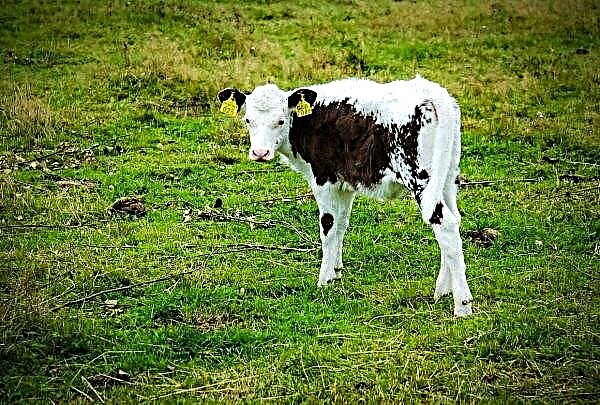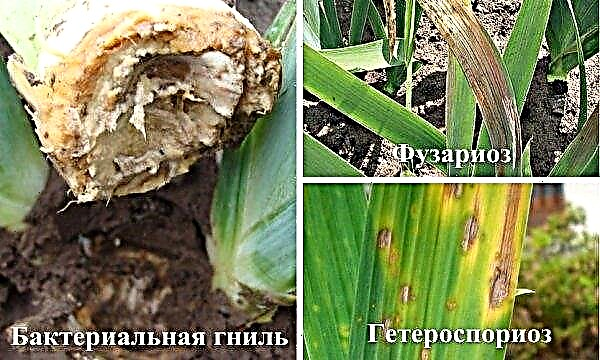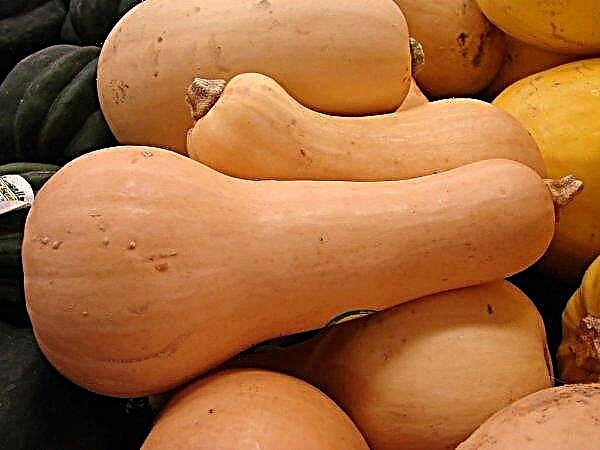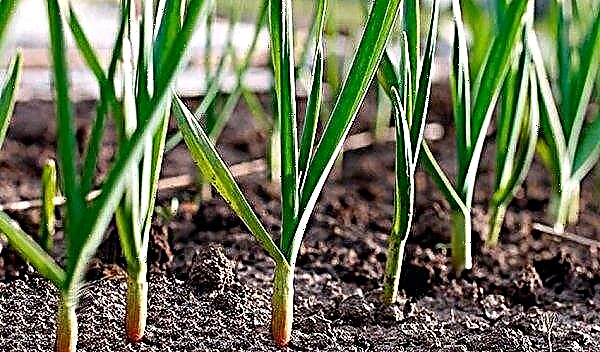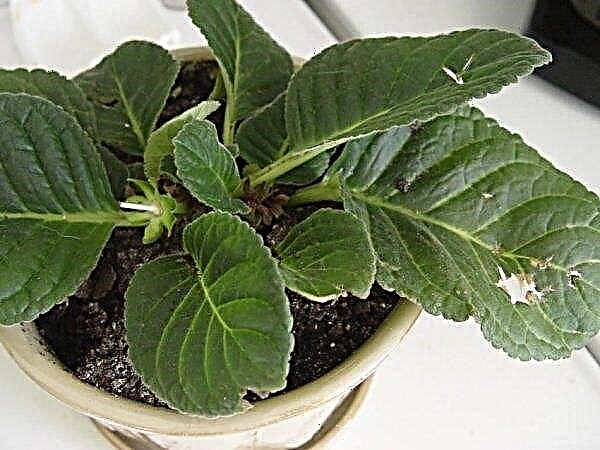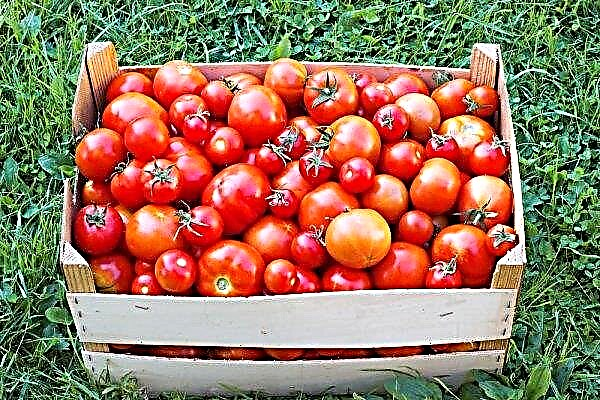While farming, each gardener sometimes encounters certain problems. Blueing of cabbage leaves is not always a threat to the plant, but sometimes it can indicate serious symptoms. Timely notice and solve problems this article will help.
The reasons for the appearance of a purple hue
Staining of cabbage leaves in violet color can be caused by various reasons:
- with a lack of a trace element such as nitrogen, not only the color of the foliage changes, but its growth stops. Such symptoms are mainly characteristic of early varieties in springtime, in cool rainy weather, when the vital activity of soil microflora is weakened and nitrogen practically does not enter the seedlings;
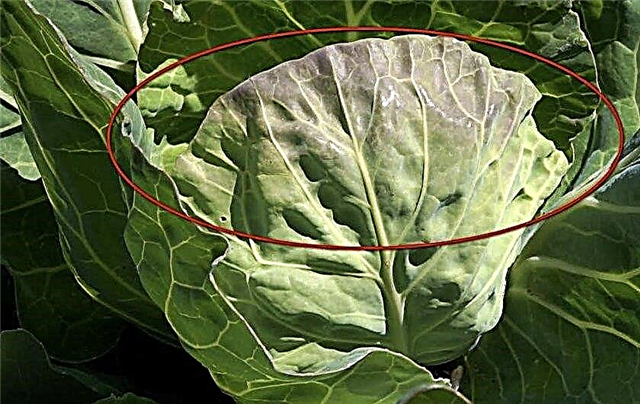
- phosphorus starvationIn addition to the violet color, it also causes shredding of foliage and a decline in the development and formation of a head of cabbage;
- when transplanting seedlings are stressed, which affects the appearance of purple leaves;
- sharp temperature changes, cooling can also provoke a change in color. So, for example, unhardened seedlings when planting them in unheated soil (and at air temperatures below + 16 ° C), change the green color to bluish;
- lack of moisture, as well as waterlogging, is able to affect the color change of cabbage foliage. Cabbage is a moisture-loving culture, but excess moisture can cause root decay and plant death. Dry soil makes cabbage leaves hard, dry, with a blue tint;
- at any stage of development, cabbage can be affected by a black leg fungal disease. First, the root system suffers, then the normal nutrition of the plant ceases, which provokes the appearance of a purple color of the leaves, and then the death of the plant;

- defeat of keel cabbage manifested in the poor development of leaves, their blue color and in the withering of the whole plant (especially at noon). This happens due to the formation of growths on the root system;
- besides diseases blue foliage can cause various pests. It can be an aphid or a cabbage fly. While aphids are clearly visible, the larvae of the fly, located in the stalks of cabbage, gnaw through them in numerous passages.
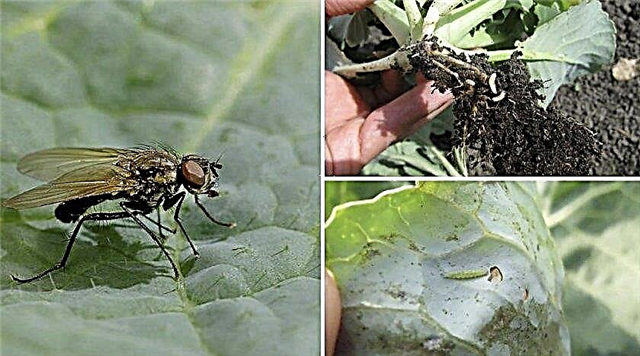 The first sign of the presence of larvae is the turning of blue veins of leaf blades, and then the wilting of the foliage.
The first sign of the presence of larvae is the turning of blue veins of leaf blades, and then the wilting of the foliage.
If violet is caused by stress factors, then after normalization of lighting, humidity or temperature, a green tint reappears after 10-12 days.
Repair methods
The ways to get rid of the blue color of cabbage depend on the reasons that caused it. Depending on this, the solutions to the problem differ.
Timely fertilizer and nutrient management
With a lack of nutrients or with a violation of moisture, the following methods are effective:
- The lack of phosphorus can be compensated by the introduction of Isagri liquid fertilizer, in which, in addition to phosphorus, there are components necessary for the assimilation of this trace element. Superphosphate (100 g per bucket of water) or double superphosphate (50 g per volume) are also considered suitable sources. As proven agents, bone meal (1 teaspoon / 1 liter of water) or organic fertilizers in the form of rotted manure or chicken droppings (about 3 kg / m²) are used.
- It has been proven that phosphorus uptake is dependent on soil acidity.. The higher the acidity, the worse the absorption of this trace element. In this regard, liming should be carried out on acidic soils by applying lime or dolomite flour, slaked lime, peat or wood ash, and ground chalk. The introduced doses depend not only on the level of acidity, but also on the type of soil. You must also know that it is better to introduce a smaller amount of the recommended dose than to exceed it.
- Blueing of cabbage with a lack of nitrogen is eliminated by the introduction of rotted manure (3-4 kg / m²). Mullein solution (1 l / 10 l) can also be used. Ammonium nitrate (20 g / 10 l) or urea (30 g / 10 l) are suitable as nitrogen fertilizers.
- In case of heavy and prolonged rains, it is necessary to stop wateringso as not to cause waterlogging. If there is a lot of rainfall, cover the beds as much as possible with plastic wrap, make furrows for the outflow of water and more often loosen the soil. Dryness of the soil is easier to avoid: you need to spend 2-3 liters of water under each bush. With moisture normalization, the leaves turn blue after 7–10 days.
 Nitrogen fertilizers are poorly absorbed with a lack of phosphorus.
Nitrogen fertilizers are poorly absorbed with a lack of phosphorus.
Prevention of temperature violations, temperature drops
Cabbage is a cold-resistant crop, but sharp temperature changes can cause foliage to turn blue.
To prevent this from happening, there are several options:
- insulate plantings with agrofibre or spanbond. White agrofibre withstands cooling to -10 ° C, and also protects against various natural disasters (hail and snow);
- mulching with peat, straw, humus or other suitable materials also helps;
- but even if you do not take any of the above methods, then the bluishness caused by temperature changes during warming will go away by itself.
Did you know? Cabbage is so popular that monuments are erected to it. In Kemerovo there is a monument to the vegetable in which the child sits. There is a similar construction in Tomsk. In Veliky Novgorod, the monument consists of 3 heads, between which are rubles, dollars and euros. And in the Chinese city of Jiangxi, the sculpture of cabbage reaches a 6-meter height.
Prevention and control of pests and diseases
The appearance of a blue color of cabbage can be the result of damage to various diseases or pests. It would be good to take preventive measures.

But if the defeat has already occurred, then first you need to determine the cause of the change, and then take appropriate treatment:
- "Blackleg" appears with a lack of lighting and air with too dense plantations, therefore, crops and plantings should not be very thickened. For prophylaxis, in the evening, before sowing, the wells should be poured with a solution of calcium nitrate or lime milk (1 tbsp of lime per 10 liters of water). With a weak lesion, 1% potassium permanganate solution can be used, up to 1 liter is consumed under each bush. In case of a more severe defeat, “Fundazole” or “Planriz” are used according to the instructions. If all else fails, then all plants should be removed, and the land should be decontaminated with 1% solutions of copper sulfate or potassium permanganate.
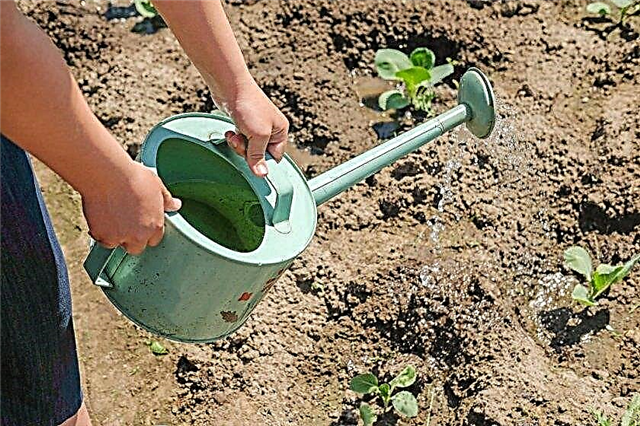
- Acidic soils often provoke the appearance of keel cabbage, so they need to be deoxidized. When planting, in each pit you can add 2-3 tbsp. l ash or 1 tbsp. calcium nitrate and pour 1.5 liters of water. Liming is also undertaken (200 g / 1 m²). If infection has occurred, then the treatment is ineffective, the bushes need to be removed and burned, since the source of infection persists for up to 7 years.
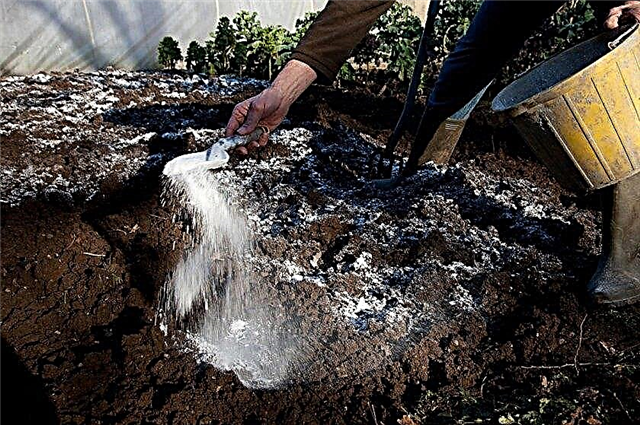
- To scare away the cabbage fly, dusting is used with a mixture of black pepper with mustard (1: 1) or ash with ground tobacco (1: 1). For this purpose, planting of marigolds, wormwood, parsley and other aromatic plants are suitable. If the larvae have already penetrated into the root of cabbage, then they are treated with insecticides (Karbofos, Topaz, etc.)
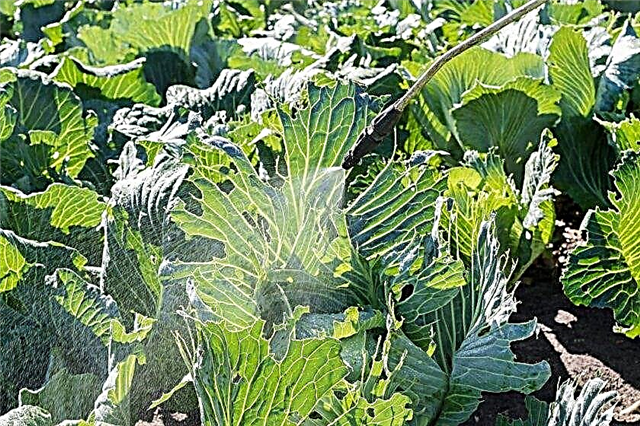
- To prevent the aphid invasion, ash dusting is used, spraying with a solution of yarrow (pour a third of a bucket of grass with boiling water and infuse), infusion of citrus peels (1 kg / 10 l of boiling water) or garlic broth (boil 400 g of uncleaned heads for 2 hours in 10 l of water). Good results are obtained by treatment with Fitoverm, which is quite harmless and quickly destroyed.

- Summing up, we can conclude that for preventive purposes it is necessary:
- harden seedlings;
- timely provide the necessary nutrients;
- Do not thicken plantings and do not overmoisten the soil;
- carry out preventive measures;
- choose disease resistant and cold varieties.
Features of planting and growing
Having discussed all the possible reasons for the blueing of cabbage leaves, it is also necessary to recall the importance of choosing disease-resistant varieties, planting on suitable soil and proper care.
Important! Transplantation and any movement is perceived by plants as stress. For this reason, after landing on a permanent place, you need to provide good lighting, do not overmoisten the soil and do not feed for about 10 days.
The right choice of variety
When choosing a cabbage for planting, you need to consider such points:
- plant varieties suitable for your climate zone;
- it is better to produce varieties of different ripening;
- such late varieties as Kilaton or Ramkila, mid-ripening Kilagerb and Tequila, and also early Kilagreg and Kazachok possess good keel resistance;
- many gardeners love the late hybrid Aggressor, suitable for all climatic regions. It is resistant to late blight, fusariosis, as well as attack by aphids and fleas. Similar qualities are possessed by the varieties Snow White, Amager and Moscow;
- such early varieties as Flash, Dawn, Legat or Aigul, as well as mid- and late ripe Brigadier, Potomac, Kharkov Winter and Centurion are popular with vegetable growers of Ukraine and the South of the Russian Federation;
- early middle varieties Cossack or June, mid-ripening varieties Kilagerb, Rinda or Slava 1305 and late ripe Ramkila, Stone head, Megaton or Kronos are suitable for the middle lane;
- In Siberia and the Urals, cold-resistant early varieties of Cossack, June, Nadezhda or Tequila are grown.
 Vegetable growers usually do not stop at one variety, constantly try new ones, competently select crops, which provides an uninterrupted conveyor of vegetable products.
Vegetable growers usually do not stop at one variety, constantly try new ones, competently select crops, which provides an uninterrupted conveyor of vegetable products.
Choosing a landing place
Determining the place of landing, you need to know about the requirements of this culture:
- the vegetable is demanding on lighting, so you need to choose sunny areas;
- the best soils for cabbage are loose loam or sandy soils;
- the soil should be fertile, therefore, during autumn digging, it is advisable to add 5-6 kg of humus, superphosphate (2 tbsp. l.) and potassium chloride (1 tbsp. l.) per square meter;
- the culture loves moisture, but does not tolerate stagnation of water, so lowlands are not suitable;
- You can’t plant after such predecessors as radish, radish and other cruciferous (they have common diseases and pests);
- suitable predecessors Cereals, legumes or carrots are considered.

Care
To obtain a high-quality and plentiful crop, you must follow certain requirements in the care of the crop:
- keep rotation (return to their original place no earlier than 4 years later) and do not plant after cruciferous;
- do disinfection of the soil (copper sulfate or other suitable means) and liming acidic soils (lime, dolomite flour);
- carry out pre-sowing seed treatment and hardening seedlings;
- timely make the necessary feeding;
- carry out preventive measures to prevent diseases and pests;
- control soil moisture and conduct regular watering so that the soil is moderately moist.
Did you know? A very poisonous plant grows in the swamps of North America — skunk cabbage. Its “aroma” is similar to the smell emitted by a skunk in extreme situations. This plant is also unusual in that it is capable of thermoregulation (maintaining temperature, as in animals) due to the heat generated by mitochondria.
Armed with the necessary knowledge, even a beginner gardener will be able to grow healthy plants and get a good harvest. We hope that our recommendations will help you with this. Good luck and success in gardening!



 The first sign of the presence of larvae is the turning of blue veins of leaf blades, and then the wilting of the foliage.
The first sign of the presence of larvae is the turning of blue veins of leaf blades, and then the wilting of the foliage.



